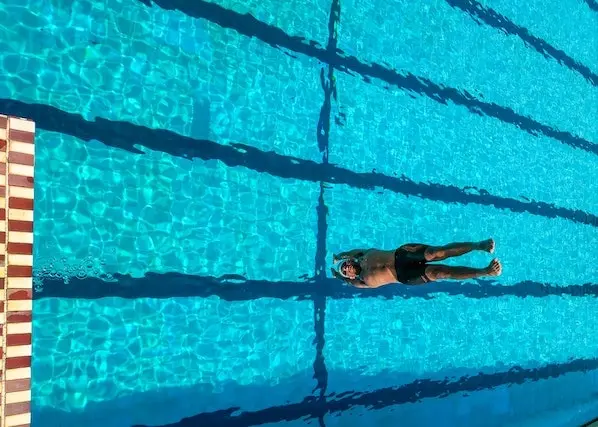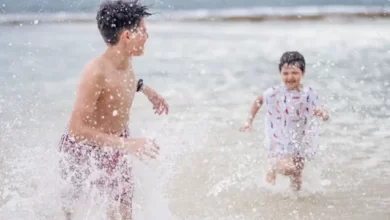Making a Splash: 10 Tips on Choosing Swim Cap and Introducing Your Baby to Water
Welcome to our comprehensive guide to introducing your precious little one to the wonderful world of water play. We understand the importance of ensuring a safe and comfortable experience for both you and your baby. In this article, we’ll provide you with ten invaluable tips, from selecting the perfect swim cap to creating a positive water introduction. Let’s embark on this exciting journey together!
Table of Contents
Why is introducing babies to water at an early age beneficial?
- Developmental Benefits: Early water introduction offers numerous developmental advantages. It encourages muscle development, coordination, and balance as babies move in the water. Additionally, the buoyancy of water supports their movements, allowing for a wider range of motion.
- Sensory Stimulation: Water play engages multiple senses, providing a rich sensory experience. The sensation of water against their skin, the sound of splashing, and the visual stimulation of a new environment all contribute to cognitive and sensory development.
- Water Confidence: Familiarizing babies with water from an early age builds confidence and comfort in aquatic environments. This foundation sets the stage for future swimming skills and promotes a positive attitude towards water.
How Does a Swim Cap Enhance the Water Introduction Experience for Babies?

- Hair Containment: A swim cap keeps your baby’s hair neatly contained, preventing it from obstructing their vision or getting in their mouth during water play. This ensures a more comfortable and enjoyable experience.
- Barrier Against Irritants: The swim cap acts as a barrier, guarding your baby’s scalp against potential irritants such as sand, salt, or pool chemicals. This is particularly important for babies with sensitive skin.
When is the right time to introduce my baby to water activities?
- Developmental Milestone: It’s normally suggested to wait until your baby is at least six months old. By this age, most babies have developed enough neck strength to support their head in a semi-upright position, making water activities safer.
- Pediatrician Guidance: It’s important to consult with your paediatrician before introducing your baby to water activities. They can give customized advice based on your baby’s overall improvement and health status.
How Can I Choose the Right Swim Cap for My Baby’s First Water Experience?

- Material Selection: Opt for swim caps made from soft, hypoallergenic materials like silicone or neoprene. These materials are soft on your baby’s skin and provide a cosy fit.
- perfect fit: Select a swim cap that offers a perfect yet comfortable fit. This makes sure it stays in place during water play, stopping water from entering and keeping your baby’s hair protected.
- UV Protection: For outdoor water play, think about a swim cap with UV protection. This gives an extra layer of covering against the sun’s harmful rays, making sure your baby’s scalp is shielded from possible sunburn.
What Are the Key Features to Look for in a Baby-Friendly Swim Cap?
- Reinforced Edges: Look for swim caps with reinforced edges. This feature enhances durability, ensuring the cap can withstand regular use without fraying or tearing.
- Adjustable Straps: If available, adjustable straps allow you to customize the fit of the swim cap to your baby’s head, providing an extra level of security during water play.
- Smooth Seams: Caps with flat, smooth seams are less likely to cause skin irritation, ensuring your baby’s comfort during water activities.
- UV Protection and Hypoallergenic Materials: These additional features can enhance the cap’s suitability for outdoor water play and ensure it is gentle on your baby’s skin.
How Can I Ensure a Proper Fit for the Swim Cap on My Baby?
- Accurate Measurement: Measure your baby’s head circumference just above their eyebrows. This measurement will guide you in selecting a swim cap that provides a snug yet comfortable fit.
- Avoid Overly Tight Caps: While the cap needs to fit securely, avoid choosing an overly tight cap, as this can cause discomfort for your baby.
What Are Some Fun Ways to Familiarize My Baby with Water While Wearing a Swim Cap?

- Gentle Splashing: Start with activities like gentle splashing in a baby pool or a shallow basin of water. Use your hand or a soft toy to create small, controlled splashes, allowing your baby to become accustomed to the sensation of water.
- Warm Bath Time Play: Incorporate water play into bath time. Use cups or toys to gently pour water over your baby’s body, making bath time an enjoyable water introduction.
- Engage with Toys and Songs: Introduce water-friendly toys and sing songs that involve simple water movements. This creates positive associations with water and helps build your baby’s confidence.
How Can I Ensure a Positive First Water Experience for My Baby?
- Choose a suitable environment: Opt for a calm and shallow water environment for your baby’s first experience. A baby pool or a controlled water area with a gradual entry is ideal.
- Maintain Close Physical Contact: Hold your baby soundly, providing constant physical contact and consolation. This helps them feel safe and supported as they explore the water.
- Pay Attention to Cues: Notice your baby’s behaviour closely. If they show signs of distress or discomfort, such as crying or tensing, slowly and gently remove them from the water and try again at a later time.
What Precautions Should I Take When Introducing My Baby to Water for the First Time?
- Maintain Close Supervision: Always keep your baby within arm’s reach, even in shallow water. This ensures that you can respond quickly to any unforeseen situations.
- Avoid Strong Currents: Stay away from areas with strong currents or deep water. Stick to controlled water environments where you can easily manage the water level.
- End the Session if Distressed: If your baby shows signs of distress, such as excessive crying or signs of discomfort, it’s important to end the water session and try again at a later time.
How can I encourage water confidence and safety as my baby grows?
- Gradual Progression: Continue to expose your baby to water in a controlled and positive manner. As they become more comfortable, gradually introduce them to more immersive water experiences.
- Enroll in Parent-Baby Swim Classes: Consider enrolling in parent-baby swim classes led by certified instructors. These classes provide a structured environment for you and your baby to learn water safety skills together.
- Emphasize Water Safety Practices: As your baby grows, emphasize basic water safety practices like floating on their back and basic water skills like kicking and paddling. These skills form the foundation for future swimming abilities.
Conclusion
With the right swim cap and thoughtful introduction, you’re setting the stage for a lifetime of enjoyable water experiences for your little one. Remember, every baby is unique, so adapt these tips to suit your baby’s individual preferences and comfort level. By following these steps, you’ll be fostering not only a love for water play but also crucial water safety skills. Here’s to many happy and safe splashes together!

Should I Apply Sunscreen on My Baby’s Scalp Under the Swim Cap?
It’s generally suggested to avoid applying sunscreen directly to your baby’s scalp, as it can be difficult to remove and may irritate their tender skin. Instead, opt for a swim cap with UV protection to shield their scalp from the sun’s harmful rays. If you’re concerned about sun display in other areas of your body, consider using baby-safe sunscreen on exposed skin.
Can I Use a Swim Cap in Chlorinated Pools and Saltwater?
Yes, swim caps are designed to be used in both chlorinated pools and saltwater environments. High-quality swim caps made from materials like silicone or neoprene are resistant to chlorine and can withstand the salinity of saltwater. However, after each use, it’s compulsory to rinse the swim cap with fresh water to remove any residual chemicals or salt and allow it to air dry. This will help prolong its lifespan and keep it productive.




